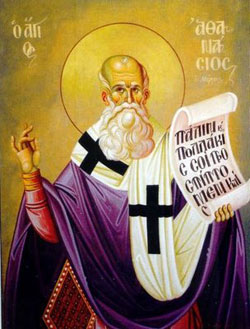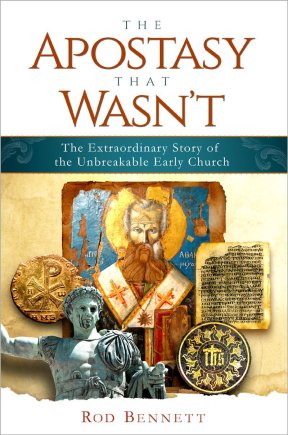One of the most common historical objections against the Catholic Church goes something like:
“The Catholic Church was founded by the Emperor Constantine forcing the early church to fall away from preaching the simple gospel and into the arms of pagan rituals and traditions like worshiping of idols”.
Historians have repudiated this old canard over and over, but it still manages to make its way into the lips of anti-Catholics who used it as a blunt instrument against the Catholic Church. However, the witness of history firmly disabused many accusations made to discredit the historical and doctrinal claims made by the Catholic Church. As Blessed Cardinal John Henry Newman, wrote in his conversion story to the Catholic Church:
“To be deep into history is to cease to be protestant.”
Blessed Cardinal John Henry Newman
He wrote these words after a long journey, which he first started as a quest to disprove the historical claims of the Catholic Church in favor of those made by the Church of England.
Today many claim that the simple gospel of Christ was lost in early Christianity and the church that Christ founded fall into apostasy. The problem with such statement is that it is simply false. This is the main point that historian Rod Bennett makes in his new book: “The Apostasy That Wasn’t: The Extraordinary Story of the Unbreakable Early Church”. In it the author traces the events that led to the First Council of Nicaea in 325 A.D and the tumultuous time that ensued it.
The Apostasy That Wasn’t is a truly riveting story of the heroic early Christian church that defended Christianity against the threats of heresy, schism and court intrigue. It shines a bright light on the unbroken continuity of church teachings and the heroes that defended it.
The “Ghetto Church” and Martyrs
The book highlights the growth of Christianity post-apostolic times and the role that the Jewish diaspora and God fearing people (gentiles that became acquainted and adopted many, if not all elements of the Jewish religion) played in fueling the growth of the early Christian church.
The author does not shy away from what he calls the “ghetto church” which grew at a time of relative peace and acceptance of Christianity that occurred after the major early persecutions of Roman authorities against Christian and prior to the Diocletian persecution of the early 300’s. The “ghetto church” slowly grew out as Christians became indifferent about their faith as evident by the number of scandalous behaviors committed not only by the laity but also by the clergy. The moral state of many churches is very well documented by a number of synods convened by bishops to address their scandalous behavior.

The shallowness of some Christians became self-evident when the Diocletian persecution started in full force. Whole parishes renounce their Christian faith as soon as the persecution was in full swing. One cannot help but to think of today’s stagnant Christians, those who are neither warm nor cold, but just going along with the culture. What would be on them if faced with such persecution? However, this only had the effect to prune the flock. Many more Christians remained faithful. As the author points out soon after the persecution started many in the Empire knew of a Christian who was either tortured or killed by the pagan authorities. Some years later Emperor Constantine witnessed with his own eyes the cruelty committed by his predecessor when he called the Council of Nicaea:
“At this period many individuals were richly endowed with gifts; and many, like the holy apostle, bore in their bodies the marks of the Lord Jesus Christ. James, bishop of Antioch, a city of Mygdonia, which is called Nisibis by the Syrians and Assyrians, raised the dead and restored them to life, and performed many other wonders which it would be superfluous to mention again in detail in this history, as I have already given an account of them in my work, entitled Philotheus. Paul, bishop of Neo-Cæsarea, a fortress situated on the banks of the Euphrates, had suffered from the frantic rage of Licinius. He had been deprived of the use of both hands by the application of a red-hot iron, by which the nerves which give motion to the muscles had been contracted and rendered dead. Some had had the right eye dug out, others had lost the right arm. Among these was Paphnutius of Egypt. In short, the Council looked like an assembled army of martyrs”.
Theodoret
Ecclesiastical History, Chapter 6
Such witness not bore in words, but with their own body cannot only move mountains, but also tear a pagan heart and replace them with a human heart…
St. Athanasius the “black dwarf” and the Dessert Fathers
Rod Bennett continuously hits high marks in his narrative approach to the story by allowing history to speak for itself. He accomplished this by extensively quoting contemporary sources, such documents from the council or from historians that were fairly close to the events.
One figure that comes to life through the witness of contemporary historians is St. Athanasius of Alexandria a “short and dark priest from Alexandria. He was the assistant to the Bishop of Alexandria named Alexander during the Council of Nicaea and as his successor, he heroically defended orthodoxy in the tumultuous times that followed the council.
St. Athanasius was one of the ascetics from the dessert. A humble Christian community of hermits who renounced all wordily good in favor of a devout life dedicated to prayer, self denial and fasting. It is from this community that emerge the early prototype of monastic life that later would have not only change Europe, but save civilization from the dark ages of the Barbarians that occurred after the fall of the Holy Roman Empire. It was this saintly community who adopted St. Athanasius as a young child in order to provide him a safe haven from the full blunt of the Roman persecution.

History tells us that this community was founded by young and rich Christian Roman, named Anthony of Coma, who, after hearing a sermon decided to give up everything to the poor and devoted himself to a secluded and ascetic life of prayer in the dessert. Not long after, many others joined him and formed a community known today as the desert fathers. Many miracles and conversion were attributed to the desert fathers:
“Many sufferers in body who where present did the Lord heal by [Anthony’s hand]; and other he purged from demons….And certainly Anthony did not heal by his own authority, but by praying and calling on Christ; so that it was plain to all that was not he who did it, but the Lord, who through Anthony showed love to men, and healed the sufferers”.
Life of Anthony
Athanasius
(Quoted from The Apostasy that Wasn’t)
This was the community that received young Athanasius and instructed him in the fullness of the gospel of Christ with humility and obedience. His brilliant clarity and orthodoxy were evident in a treaty that he published early in his career titled: “On the Incarnation”. Today it is universally viewed as a theological masterpiece. C.S. Lewis the great 20th Christian apologist wrote:
Link to “On the Incarnation”:
http://www.newadvent.org/fathers/2802.htm
“When I first opened De Incarnatione [On the Incarnation] I soon discovered by a very simple test that I was reading a masterpiece, for only a master mind could have written so deeply on such a subject with such classical simplicity.”
C.S. Lewis
“On the Incarnation” gives us yet another window of what Christians believed in the early fourth century. Its clarity and simplicity reflects greatly the integrity of the teachings of the Christian church in the early centuries of Christianity. One key component of the doctrine of the incarnation is the fact that God was made flesh. That is: Jesus was truly man and truly God. In that way as Christ hung from the Cross so did death and corruption, ultimately meeting their demise in the Resurrection:
“The death of all was consummated in the Lord’s body; yet, because the Word was in it, death and corruption were in the same act utterly abolished.”
St. Anthanasious
On the Incarnation
It was this young priest who wasn’t even old enough to vote at the council that stood up with clarity and conviction along with the council fathers against those who denied the divinity of Christ.
To be continued…

